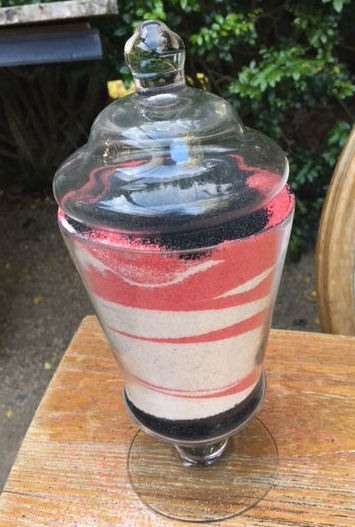Unity Sand Ceremony
Categories: | Naming Ceremonies | Wedding Ceremony | Wedding Rituals |
 The Sand Ceremony involves the pouring
of sand, representing individuals, from separate
smaller containers into one large one, either
consecutively to form identifiable layers, or
simultaneously, blending the sands to symbolise the
joining of lives. It is therefore particularly
suitable for situations where the lighting candles of
is impractical (such as outdoors).
The Sand Ceremony involves the pouring
of sand, representing individuals, from separate
smaller containers into one large one, either
consecutively to form identifiable layers, or
simultaneously, blending the sands to symbolise the
joining of lives. It is therefore particularly
suitable for situations where the lighting candles of
is impractical (such as outdoors). It is a unity ritual that has many layers of symbolism that differ from the more ephemeral symbolism of the Unity Candle and reach further back in time and human history than the invention of candles or the discovery of fire. It is also a ritual that can involve the two of you, or include other people, usually family members. It is perfect for blending families, where one or both of the marrying couple is bringing children into the marriage, and for baby naming ceremonies to symbolise the expansion of the family.
While the Unity Candle will eventually be consumed by burning, the permanent artifact of a Sand Ceremony is a glass container filled with non-biodegradable sand that is structurally millions of years old, a powerful representation of stability, continuity and eternity.
Choose what you want your
Sand Ceremony to symbolise
out
A sand ceremony can take a number of different forms:- emphasising the merging of two lives
- recognising that while two lives join, each person remains an individual
- recognising the addition of a child to a family
- emphasising the merging of two families
- using coloured sands to represent individual
qualities or intentions
What you will need for your
Sand Ceremony
out
Minimum requirements are:- A glass container into which to pour the sand
- Two smaller glass containers for the couple
- A smaller glass container for each additional person (if any) participating in the ritual
- Sand
You will need two different types of container: the larger central container, representing your relationship, your marriage, and your new life, to pour the sand into, and smaller containers to pour the sand from. Because you will want to keep the larger container with the blended sand in it, you’ll require some means of making sure the sand stays in it.
The containers should be glass because glass is made from sand and other ingredients fused by heat; therefore glass is a powerful symbol of permanence.
You can add your own unique touch to the ceremony by choosing containers that hold personal meaning or reflect your own personal style. Some of the more unusual containers chosen by couples I have officiated for include the bride’s grandmother’s crystal powder bowl, a decanter sourced from a charity store for a few dollars, a vase engraved with their names and wedding date, a decorative bottle, and the empty bottle from the wine they shared on their first date. Using a previously used container is not only a romantic choice, but an ethical one.
Consider also the form of Sand Ceremony you will use. If you are blending the sand your objective can easily be achieved regardless of the shape, size or diameter of the container. If you are planning to pour the sand in distinct layers, a taller container, symmetrically shaped, of a smaller diameter will allow the layers to be deeper and therefore create a greater impact.
For the containers from which you pour the sand, you can use smaller bottles, shells, shot glasses, wine glasses, champagne flutes, or any container that will hold an appropriate amount of sand and be comfortable to hold and pour from. If you have purchased a pair of engraved champagne flutes for your toast to each other, use those. Just make sure you delegate someone to retrieve them, give them a quick wash and dry, and ensure that they are taken to the reception venue and added to your place settings.
A number of retailers sell kits for sand rituals, some of which are more practical than others. Most of the sand ceremony kits have relatively wide mouthed vases, though some come with corks (requiring you to use some sort of funnel to make sure the sand doesn’t go everywhere while you’re pouring it).
For open mouthed vases or containers, you can seal the top of the sand with melted candle wax after the ceremony, or you can fill the space with clear gel wax and embed a wick in it. Or you could use a lidded container.
Sand
Crystalline sands can be purchased in numerous colors. However, it is a simple matter to color your own. Colouring your own sand with chemical free food colouring creates vibrant colours without environmental harm. As does making sure that your sand is ethically sourced without environmental harm.
- Buy white sand from an aquarium supply store
- Measure out the amount you need for a particular color on a metal oven tray (or use an aluminum foil pie plate or loaf pan)
- Add food coloring a drop at a time stirring until you have the color evenly distributed through the sand
- Place in the oven at a very low heat until
thoroughly dry.
- Then pour it into a clean dry bottle and seal until ready to use.
It is important to keep the sand dry so that it flows freely when poured. In conditions of high humidity, the sand may become damp and will clump, inhibiting flowing. So ensure that your sand is kept thoroughly dry by keeping it sealed until you are ready to use it.
On the day, give it a good stir to break up any lumps.
Using beach sand or soil
out
Another variation - and how the very first sand
ceremonies were done when the ritual was first
invented back in 1993 - is to use sand from a beach
that means a lot to you, or use soil from your
childhood home etcIf you choose either it is critical that you make sure that the sand/soil is well sifted to remove any organic matter that could rot (and subsequently stink), and that the sand/soil is well sterilised by heating it in the oven. If transporting soil or sand from one country to another it is important to note that inorganic "powders". such as sand are subject to a weight limit (currently 350g, but your should check) and you may need a permit. Enquire early to make sure that it isn't confiscated at the border. It is also important to make sure you aren't transporting nasties like fireants.
Be careful what you add
out
You can add glitter to your sand. Choose the glitter
wisely!You can also dried lavender or freeze-dried rose petals between each layer of sand, or just to top it all off. Both have lovely significance - lavender representing devotion, and roses being the universal flower symbol of love - but you will need a wide-mouthed jar to accomplish this effectively, and you must make sure that the lavender or rose petals are completed dry so they won't rot.
Preserving your Sand
Ceremony layers for the future
out
After the ceremony you will be transporting your Sand
Ceremony container To make sure the contents don't
move and destroy the layers- Make sure that the jar is full to the top
- Make sure that the jar is securely capped.
- Where your chosen container doesn't come with a stopper you can manufacture one from cork (might need to be trimmed), carve one from wood, or find a stopper that will fit. You can also seal the top with a thick layer of melted wax.
More
out
For a detailed guide that broadens the reach of the
sand ceremony terms of inclusiveness, reflects current
environmental sensitivities, and provides many example
narrative components to borrow or adapt